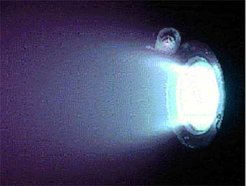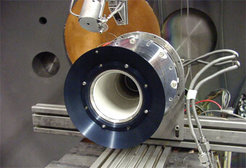Travelling light in outer space
Know-how from fusion research for space technology / electrostatic propulsion

Ion drives, like conventional rocket propulsion systems, work on the thrust principle: however, the fuel is not combusted but electrically charged, i.e. ionised. This produces a plasma composed of electrically charged particles, viz. electrons and ions. The ions are accelerated in electric fields. This creates a high-energy particle beam whose thrust propels the spacecraft forward. The electric power required is supplied by solar cells. “Ion drives are very interesting for propelling satellites”, explains Dr. Philip Willemsen of DLR, “because in comparison with conventional chemical propulsion systems they are often capable of attaining higher exit velocities of the beam particles. As less fuel is needed this way, the initial mass of the satellite can be smaller. This can afford distinct cost advantages and greater flexibility. The proven competence in plasma theory and the special preliminary work of the Junior University Group around Dr. Ralf Schneider make IPP an ideal partner for advancing the theoretical description of ion drives.”
The development of ion drives has hitherto been largely a matter of experience. In order to improve their performance further – in view of the progress in numerical modelling and in describing the plasma’s behaviour in these propulsion systems – computer models are now also being enlisted. The project will concentrate on so-called HEMP drives: In this High-Efficiency Multistage Plasma drive of the Thales company in Ulm the fuel is ionised in a magnetically focused direct-current plasma. The electric fields needed to accelerate the ions are generated by themselves through the magnetic confinement of the plasma.

The properties of the drive plasma can be influenced by, for example, the shape of the discharge vessel, the location of the gas inlet and electrodes, and the topology of the magnetic fields. In order to describe the micoscopic plasma behaviour in HEMP drives and hence allow operation and performance characteristics to be predicted, the scientists around Dr Schneider are now using codes from fusion research. These were originally developed to calculate the interaction of fusion plasmas with the enclosing vessel walls.
An understanding of plasma physics is indeed necessary here: for example, the enhanced energy loss of electrons in the ionised fuel is inadequately clarified – a major problem in the development of efficient ion drives. A possible cause could be fluctuations arising from plasma instabilities, or else interaction of the plasma with the walls. In many respects this is reminiscent of two problems in fusion plasmas, viz. turbulent anomalous transport and plasma-wall interaction.
How powerful the new modelling tools are will then be checked by comparing them with experiments conducted by Thales in Ulm under the terms of a sub-contract. The aim is to keep the simulation software so general that ultimately it will be not only the physics of the HEMP drive that can be described. The program package should also be adaptable to other plasma topologies in further projects.Isabella Milch

